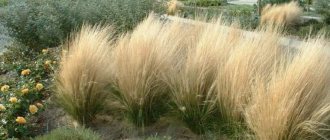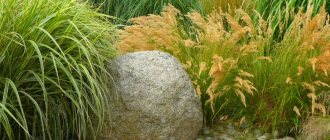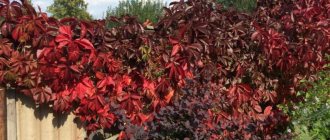Feather grass is a fairly well-known plant that belongs to the cereal family. It is a grass from 30 cm to a meter high, with a short rhizome (not creeping) and a rather dense bush. The feather grass plant is perennial and reproduces by seeds. In nature, there are about 300 species of feather grass . About 80 of them grow in our country. Under natural conditions of the steppes it often forms dense turf, but due to active agricultural activity it is now rare.
Feather grass leaves are thin and hard, reminiscent of wire, sometimes even twisted into a tube. The stems are erect and also thin. The feather grass produces a flower in the form of a dense paniculate inflorescence-spikelet at the end of May. It has a very original structure, in which the grain is located in the lower flower scale, which has a callus (pointed apex) and an awn. The bristles on the spikelet are located in the opposite direction to the awn, and the awn itself is twisted into a spiral.
Ripe seeds are spread by the wind. But there is another method, due to the unique structure of the spikelet. Under the influence of dew or rain, the stems of the feather grass take root to the ground, the spiral-shaped awn straightens slightly from moisture, and, like a corkscrew, is screwed into the ground. The scales prevent her from getting back out. Then the spikelet dries out and breaks off, and the seeds remain in the soil.
Feather grass care at home
Herbs add beauty to the garden all year round.
Even in winter, their heads, covered with snow caps, rise above the white snowdrifts. And in early spring they will be the first to delight you with delicate greenery. Herbs can be called a symbol of perseverance and perseverance. Herbs are characterized by lightness, which is lacking in plants with more massive leaves. Unfortunately, we have recently become interested in growing herbs. Once upon a time, numerous species of feather grass covered the steppes like a silky carpet. Today, many of them are considered endangered species listed in the Red Book. The decorative value of these cereals is associated with the fluffy part of the seeds, which helps them scatter over vast distances.
This is a very simple plant to grow, however, it does not tolerate transplantation at all. This is a plant that loves warmth and sunlight. Feather grass grows well in well-drained soil, completely intolerant of stagnant water. The most beautiful of the steppe grasses is feather grass; it prefers slightly alkaline, fertile soils, and is not afraid of winds or direct sunlight. Feather grass is unusually beautiful during the period of short-term flowering, when the silky awns sway in time with gusts of wind. It is imperative to control weeds in the area where the feather grass grows. To enhance the decorative effect, it is necessary to mulch the soil between the plants with expanded clay or fine gravel.
Slowly reproducing feather grass can be propagated by seeds, but to wait for flowering, you will have to wait 10-15 years. You can divide the overgrown clump in early spring.
Notes
- For the convention of indicating the class of monocots as a higher taxon for the group of plants described in this article, see the section “APG Systems” of the article “Monocots”.
- Stipa lessingiana
: information about the taxon in the Plantarium Project (plant identification guide and illustrated species atlas). (Retrieved November 26, 2013) - ↑ 12
Larin, Larina, 1950, p. 259. - ↑ 12
Red Book species Stipa lessingiana in the Red Book of the Altai Territory (Russian). Protected natural areas of Russia. Retrieved November 25, 2013. - Red Book species Stipa lessingiana in the Red Book of the Ulyanovsk Region (Russian). Protected natural areas of Russia. Retrieved November 25, 2013.
- Red Book species Stipa lessingiana in the Red Book of the Nizhny Novgorod Region (Russian). Protected natural areas of Russia. Retrieved November 25, 2013.
- Stipa lessingiana
Trin. & Rupr. is an accepted name (English). Royal Botanic Gardens, Kew and Missouri Botanical Garden. Retrieved November 26, 2013. - Stipa lessingiana Trin. & Rupr. (Russian). Protected natural areas of Russia. Retrieved November 26, 2013.
- Kovila Lessinga Stipa lessingiana Trin. et Rupr. (Ukrainian). Chervona book of Ukraine. Retrieved November 25, 2013.
Use in landscape design
Due to its modest and natural beauty, feather grass is often found in gardens and flower beds (what feather grass grass looks like can be seen in the photo below). In addition to its natural charm, this plant has another important advantage - unpretentiousness.
Of course, this does not apply to all varieties, since some of them, due to different natural growing conditions, require special care in the climate of our country. With the help of feather grass, you can create spectacular compositions that imitate the natural combinations of steppe plants. Its thin spikelets are mesmerizing, fluttering in the wind with smooth lines. It looks especially beautiful when it is planted in a large dense group.
To create a naturgarden (natural garden), next to the feather grass it is recommended to plant those plants that will look natural in combination with it, as if they were to be seen in a meadow. These are, of course, other cereals: fescue, foxtail, miscanthus and others.
Also looking impressive next to the feather grass of scabiosa, especially in bright, rich shades, poppies, heather, sage, hyssop, chamomile, echinacea, decorative onions or garlic. Moreover, feather grass can act both as the basis of a composition and as a background for more striking opponents.
Recently, landscape designers have been coming up with new and original combinations, and now cereals are favorably highlighting the beauty of rose gardens. Moreover, they look more advantageous next to climbing roses or varieties with miniature flowers.
Feather grass will fit perfectly into the plant environment of the pond next to heucheras, irises, sedges and reeds. Although it is better to place it not at the very edge of the water, since this is not a coastal plant, but, for example, along the path to the pond.
Feather grass can grow in a dense strip along a board fence, filling the space between the picket fence, and thus emphasizing the division of garden space. It will look no less beautiful next to a fence or near pergola pillars.
Despite the fact that feather grass is a steppe plant, it can be planted next to ornamental bushes, for example, Thunberg barberry or turf. It harmonizes no less beautifully with some conifers, especially dwarf varieties. Therefore, feather grass is quite appropriate on an alpine hill.
The use of feather grass in landscape design is not limited to the above, so designers continue to delight the gardener with new ideas for beautiful compositions.
Growing from seeds
The easiest way to propagate feather grass is by dividing the bush when it reaches good density. However, if it is not yet in the garden, then all that remains is to sow the seeds.
Growing feather grass from seeds does not require any special knowledge or effort. Varieties that grow in the climate of our country can be safely sown before winter - that is, in the fall directly into the ground in a permanent place. To do this, make a hole about 3 cm deep, moisten the soil and pour 3-4 seeds into it. In the same way, sowing is carried out in late April-early May during spring planting.
The soil can be purchased at the store or prepared in the fall from your garden. Feather grass is not a demanding plant, so it has no special preferences for soil. Rather, he prefers not too fertile soil. You can sow the seeds directly into separate cups, since the feather grass sprouts are thin and fragile and can be easily damaged when planted from a common container.
Sowing is usually done in March. The seeds are not planted deeply and the soil is periodically moistened. Shoots usually appear after 4 days. Seedlings are planted in the ground in May.
The photo shows the finest feather grass “Pony Tails”
When sowing feather grass seeds in the ground or through seedlings, the distance between plants is about 20 cm. Basic care comes down to periodically weeding out the weeds. If desired, you can mulch the soil.
Frequent watering or fertilizing is not required, since feather grass is a steppe plant and is accustomed to drought. The main thing is to choose a good sunny place for it, where it will not be threatened by groundwater located close to the surface, since it does not like excess moisture. Also, feather grass does not really like acidic soils, so if the acidity level is high, it is necessary to add lime.
If the feather grass bush has become dense enough, it can be divided in the spring. This is not only a method of propagation, but is also useful for the plant itself, so that it blooms more effectively.
Selecting a site for planting
How to grow feather grass in the garden Photo
To grow feather grass, you will need a place filled with sunlight. It does not tolerate dampness: the area should not be flooded; if groundwater is close, make a high bed and lay a drainage layer.
The soil is preferably limestone or gypsum. When planting in ordinary garden soil, add lime and a little coarse sand before digging.
What is feather grass like?
Despite the fact that quite a few varieties of feather grass are known, only a few of them are used for landscape design (photos and descriptions are attached):
- Feather grass is the most frequent guest of gardens and flower beds. This is no accident, since he is an original inhabitant of the Russian steppes and is accustomed to all the vagaries of our climate. It reaches a height of about 90 cm. It blooms in May-June. Overwinters without shelter. The stems of the plant are smooth, the panicles are narrow;
- Feather grass is beautiful - very similar to feather grass, but unlike it, it has denser panicles, which, under their own weight, bend towards the ground, forming a smooth bend;
- Feather grass "Fluffy Cloud" is a compact bush no more than 50 cm high, often lower. Its spikelets are erect and lush in shape, which is how this plant got its name;
- The finest feather grass comes from Mexico, so winter temperatures below 15° are contraindicated for it, as are high temperatures (over 25°). Grown as an annual. The leaves of this plant are quite hard, the spikelets are whitish with a silvery tint. Bush height - about 80 cm;
- Feather grass “Fireworks” is a perennial plant about 80 cm high; in our climate it can be an annual plant. This feather grass received its name due to the leaves changing their color, which from dark green in the spring at the end of summer become golden-pink, and in the fall they become almost red or brown;
- Zalessky feather grass is from the genus of feathery feather grass. It grows on low-humus soils and is also often found on solonetzes. The leaves are covered with hairs and pimples, the panicle is loose and slightly pubescent;
- Feather grass “Volosatik” is a plant about 60 cm high. It differs from other feather grasses by its thin and long spine (about 20-25 cm), which resembles horsehair. The color of the spikelet is silver-green;
- Lessing's feather grass is about 60 cm high. The leaves are slightly rough on the outside, curling when dry. The panicles have a purple tint, as can be seen in the photo of the plant.
Types of feather grass with photos
Today, about 300 species of feather grass are mentioned in the botanical literature, of which 100 species are distinguished by increased resistance to dry, hot climates. Let's look at the most common garden crops grown in our regions.
Feather grass (Stipa pennata)
The height of the grass arrows is approximately 30-100 cm. The surface of the stems is slightly pubescent. The leaves are narrow with pointed ends and curl into tubes. The leaf blades have a slight roughness.
The length of the inflorescences sometimes reaches 25 cm. Each contains 6-20 scaly spikelets. The scales are arranged in two rows. The brownish shoots are bent and have hairy pubescence closer to the top of the bush.
The species blooms at the end of May or June. After a month, the bushes begin to bear fruit with sharp, elongated grains. The plant grows well in loose soil with a neutral drainage environment. Excess moisture harms the grass and leads to inhibition of growth.
Beautiful feather grass (Stipa pulcherrima)
The grass is of medium length with numerous branches, pubescent at the lower part of the internodes. The leaves of the lower tier are narrow in shape with a dark green color, and the leaves of the upper tier are smooth to the touch.
The inflorescence racemes look like compressed panicles. Spikelets with a red tint grow no more than 30 cm in length and include only one flower. The surface of the spikelets is covered with a layer of hairs 3 mm wide.
This type of feather grass looks advantageous in group plantings inside an alpine hill. Individual flower beds with feather grass are mulched with crushed stone or expanded clay to hide the voids.
Flowering occurs at the end of May or June. Thanks to its attractiveness and decorative qualities, the plant fully lives up to its name. The grass successfully survives winters, even withstanding air temperatures dropping to -23°C. In nature, the most beautiful feather grass climbs onto rocks or mountain plains. The crop is planted on calcareous substrates, where the rhizome takes root well.
Since wild plantings are becoming less and less common, it was decided to include this type of cereal in the Red Book.
Feather grass (Stipa tenuissima)
Another perennial that can only occasionally be seen in our area. Strong stems reach a height of up to 70 cm. The leaf blades are rigid and rough. They have a narrow shape, like other representatives of the species. The size of the flowering panicles is about 20 cm. The panicles form spike-shaped arrows in purple tones. The main spine is bent, devoid of hair at the bottom, and, on the contrary, towards the top it is covered with short bristles.
The species blooms in the first ten days of summer. For planting, it is preferable to choose fertile black soil. Severe frosts are not harmful to grass and are easily tolerated.
Feather grass (Stipa capillata)
The culture is popularly called feather grass - a medium-sized plant with green thin longitudinal or flat leaves of a gray hue. The outer and inner sides of the plates are protected by hair. The internodes on the stems are completely inconspicuous.
The scales located at the bottom of the flower are small. Their edges also have hairs. The spine bends twice. In the lower part the spine is smooth to the touch, higher up it is overgrown with fluff. Warm steppes are one of the favorite places for feather grass to grow. Short spikelets bloom early in the season. In most regions this species is gradually disappearing.
Feather grass (Stipa magnifica Junge)
Bushes grown under normal conditions grow to a height of approximately 40 to 75 cm. In soils enriched with fertilizers, they can stretch another 15-20 cm. The leaves are twisted, no more than 7 mm wide. The flowers are framed by small hairy scales.
The main spine is usually bent once. Some varieties have peculiar “antennae”. The budding period is similar to other species. Self-sowing magnificent feather grass carpets the mountainous regions of Altai and the Urals. Even in the south, the grass takes root safely.
The finest feather grass (feather grass seeds from “Search”)
Two years ago I saw feather grass seeds in the store and immediately bought them. This ornamental grass is very elegant, its delicate fluffy spikelets sway in the wind and look simply magnificent. The seeds were from agro, this manufacturer usually does not disappoint. This time too the purchase was successful.
Although the bag says to sow feather grass in open ground, I did not do this. There are not many seeds. There is a high probability that they will not sprout, especially when it is not possible to constantly keep the soil moist. I grew feather grass through seedlings, more work, but for sure.
Feather grass seeds
I sowed feather grass seeds in March in a pot and sprinkled it with a centimeter of soil. A week later, thin hair shoots appeared. A month later there were more leaves, I picked the seedlings into separate pots. At the end of May I planted it in open ground.
In the first year, the feather grass from seeds only bushed, but did not bloom. This cereal does not particularly need watering; on the contrary, you should choose the driest, non-flooded area in the garden for it. But this summer, spikelets have already appeared (see photo).
I am very pleased with the plant - beautiful and unpretentious. It is possible to propagate feather grass not only by sowing seeds, but also by dividing the bush, but I have not tried this method yet.
Feather grass Fluffy cloud 5.00 2
Fast-growing cereal perennial 40 cm tall. The plant forms a neat, compact turfy bush, decorative throughout the season. Beautiful silver spikelets flowing in the wind are an unforgettable sight. An ideal plant for natural style flower beds: rock gardens, gravel gardens, naturgardens. Suitable for growing in containers. It combines well with other ornamental grasses and makes friends with irises, milkweeds, echinacea, annual chrysanthemums and eschscholzia. Original feather grass ears add incomparable charm to bouquets and compositions, including those made from dried flowers.
Choose a sunny, open location with well-drained, neutral soil. Add sand and compost to the soil. In the southern regions, sow seeds directly in open ground - before winter or early spring. In the conditions of the middle zone, sowing seedlings in early April, 4-5 seeds in separate pots. As a rule, stratification is not required. Planting in open ground in early June in increments of 20-25 cm. We recommend replanting plants of the first year of life into a container in late autumn and storing them in the basement in winter. 2-3 year old plants overwinter in open ground with shelter.
>Feather grass Fluffy cloud reviews
Feather grass is a wild variety of perennial plants from the grass family.
Description and photo
The drought-resistant crop does not like waterlogging and prefers loose and non-acidic soils that are well drained. Doesn't really need watering. On the contrary, when planting, you should choose the driest, non-flooded areas.
Some species are well adapted to live throughout our country. But for the spontaneous growth of this unpretentious plant with a height of approximately 30 cm to 1 m, the climatic conditions of the steppe are more suitable. Previously, scientists counted only a few varieties of perennials, but now more than 300 varieties have been identified.
The planted plant feels good with simple care and does not need to be replanted for up to 15 years.
Properties of the herb
Useful:
- Biologists believe that thanks to the long-term habitation of feather grass steppes, the accumulation of chernozem in the soil has been created.
- These cereals are the rescuers of steppe soil from wind erosion.
- Decoctions of dried roots and aerial parts, harvested in May–August, are used to treat thyroid diseases and paralysis.
- Cattle willingly eat young feather grass and hay from it, prepared in the spring and mowed before the heading period. While being good food for grazing animals before flowering, feather grass still does not have high economic value in livestock farming.
Flaws:
- When mowing frequently to obtain high-quality food from young shoots, the plant dies.
- With the onset of flowering from the end of May (some varieties bloom only at the beginning of July), the cereal is poisonous; they are prohibited from feeding goats and sheep.
- The second half of summer is dangerous for grazing on feather grass pastures. Feather grass disease affects livestock: ripe awns, digging into the skin, cause inflammation and even death of animals.
Feather grass compositions in modern decor
Almost all varieties of this unusual plant are especially popular among landscape specialists who create their works on the principles of the unique and strict beauty of wild nature. The inflorescences of the cereal, like those of all representatives of its family, are inconspicuous, reminiscent of the filaments of an electric lamp, but the extravagant appearance of the leaves and stem awaken artistic imagination. The feather grass bush is capable of spreading its delicate feathers and beautifully casting silvery silk in the wind.
Thanks to its long silky awns, which create a magical picture from the slightest breath of wind, feather grass is widely used in modern decor.
Cut, discreet inflorescences are elegant and bring unsurpassed simplicity to live and dry flower arrangements.
The unpretentious plant is specially propagated using the following:
- for decorating garden areas,
- as a component in the landscape design of the fashionable prairie style,
- when constructing alpine slides,
- in creating bouquet arrangements, especially from dried flowers and leaves.
This cereal is planted in open areas with well-drained soil in clumps, creating a natural garden, in rose gardens or on alpine hills, in the neighborhood and in combination with other plants:
- drought-resistant, with which they live in the steppe neighborhood or in meadows (fescue, foxtail, poppies, cornflowers, daisies, echinacea, heather);
- with an unusual winning combination of compositions with plants with small flowers, or roses, ornamental bushes, coniferous trees.
Types of landscape feather grasses for central Russia
What winter-hardy varieties can lovers of modest exotics buy in the middle climate zone?
For example, in the Moscow region, when decorating territories, preference is given to several types of this cereal:
- Feather grass is popular in gardens and flower beds for a reason. This original inhabitant of the Russian steppes is accustomed to all climatic vagaries. Does not require shelter for the winter.
- The beautiful feather grass is similar in appearance to its feathery counterpart.
- The compact bush is called “Fluffy Cloud” due to its lush shape.
- The finest feather grass, growing in Mexico, is demanding on temperature conditions: in winter no lower than 15°C, in summer no more than 25°. “Capricula” is grown as an annual.
- "Fireworks" is unique in that it changes the color palette of its leaves, turning into rich greens, gold, pink, red and completely brown depending on the season.
- Zalessky's feather grass feels good on salt licks.
- “Hairy” looks like horsehair with a silvery and greenish tint.
- Lessing's feather grass is unique due to its unusually curled leaves when dry and a panicle with a purple tint.
Types and varieties
Previously, botanists identified only a few species:
- Feather grass is feathery. The plant is recognizable by its long white “feathers” visible from afar. Latin name – Stipa pennata.
- Lessing's feather grass produces small sods. In addition, it is much smaller than the first type.
- Tyrsa. Instead of "feathers" it has hair-like awns.
Feather grass of Lessing
Today another classification has appeared. It turns out that feather feather grass is divided into many species. The differences between them are insignificant, but still there.
- Zalessky feather grass. Its ears are edged with a tongue similar to a panicle. It is a xerophyte, meaning it can easily withstand dry climates and extreme heat. You can meet it in western China and some regions of Russia. It was discovered by the Soviet botanist D. Vilensky.
- Feather grass angustifolia has bare stems. Easily trampled, grows in Asia Minor and the Mediterranean.
Also used for decorative purposes are feather grass and feather grass, hairy-leaved feather grass and Fireworks. The plot or flowerbed will immediately be transformed!
Features of care
In the modern trend of easy neglect of the garden, care does not require special agrotechnical methods. Feather grass perfectly meets these requirements, possessing both decorative and unpretentious growth.
These grains are easy to grow even for inexperienced gardeners.
The requests of the “steppe emigrant” are elementary:
- Planting material is planted in a dry, sunny area of the site, inaccessible to flooding by groundwater.
- The steppe inhabitant easily tolerates prolonged water shortages.
- Weeds are weeded out as needed.
- You can mulch the soil.
- Add lime to the soil if it is highly acidic.
- Bushes that have become dense need to be divided - this is both propagation and plant care.
- Additional watering and fertilizing are not required (watering very moderately can only be done during rooting of seedlings or when replanting a divided bush, without special requirements for the technology of the procedure).
- In autumn, without touching the leaves, cut off only dry inflorescences.
Diseases and pests
Diseases rarely affect this plant. Feather grass has virtually no natural pests. Its tough leaves will not be a treat for insects. The only problem is mites and aphids. There are 2 ways to help the gardener get rid of them:
- rinse off with strong water pressure,
- treat with soapy water.
As a result, it should be noted that feather grass compositions have firmly won the hearts of residents of all regions of our country. Let landscape designers and amateurs continue to amaze with unusual but beautiful compositions using feather grass.
Briza, or shaker
Briza media is a common meadow plant in temperate climates. This pretty herb is widely known among people as “cuckoo’s tears.” But among flower growers, the most widespread is the large shaker (briza maxima), which is most often used to create original winter bouquets.
Large shaker (briza maxima). © Benjamin Shafir
The inflorescences of the breezes resemble small flattened teardrop-shaped catkins that easily sway and shake in the slightest breeze (hence the name “shaker”). The clumps of this grass look rather loose, and the simple linear leaves do not have much decorative value, so I prefer to plant Briza so that its foliage is masked by bushy plants.
Since briza bushes do not grow wide enough, for the greatest decorative effect they must be planted in a group, placing the seedlings as close to each other as possible.
“Cuckoo's tears” can find their place in compositions with petunia, snapdragon, heliotrope, verbena and other bright annuals from 20 to 40 centimeters in height.
Briza major is an annual plant by nature. However, this small disadvantage is compensated by incredibly fast growth and early flowering. Annual shaker can be sown in a permanent place in early May. Shoots appear quickly, and seedlings do not require special care. Flowering begins in July-August.
I would also like to note an equally interesting variety of perennial breeze of the middle Russels. The original grass, in addition to its attractive inflorescences, is notable for its striped silver-white foliage. The plant is unpretentious and cold-resistant; it develops better in the sun, although it can also tolerate light partial shade. This shaker reaches a height of 60 centimeters along with peduncles and is best planted in garden flower beds, where the breeze can overwinter without any shelter. Since the "Russels" grass is of hybrid origin, it is best to propagate the grass by dividing the bush.











